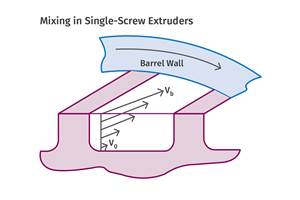Extrusion: Multi-Pass Tubing Tank Offers Higher Quality, Resin Savings
A new cooling and sizing tank for extruded tubing reportedly allows processors to reduce wall-thickness tolerances and cut material use dramatically while increasing productivity and reducing floorspace requirements.
A new cooling and sizing tank for extruded tubing reportedly allows processors to reduce wall-thickness tolerances and cut material use dramatically while increasing productivity and reducing floorspace requirements. Developed by Conair Extrusion, Cranberry Township, Pa. (conairgroup.com), the new MedLine MultiPass unit is especially suited for medical tubing.
The tank is so named because it eliminates the series of tanks that are typically used for cooling and sizing tubing. Instead, an oversized, driven roller at the end of the tank reverses the direction of the tube as it exits the vacuum chamber and guides it in a second pass through the cooling water. With new OD, ID, and wall-thickness control algorithms, new tension-control devices, and precision puller technology, this unit reduces tolerances to levels never seen before, according to Conair.
“Like any multi-pass tank, this new unit cuts floorspace requirements by sending the tubing along a back-and-forth path through the cooling water, but that’s where the similarity ends,” explains Bob Bessemer, medical downstream extrusion sales manager. Vacuum sizing is the biggest distinction between this and other models, he adds. “Vacuum sizing is inherently more controllable than air-pressure sizing, and we’ve demonstrated success in extruding flexible PVC, TPE, TPU, and PE commodity tubing,” Bessemer says. “For instance, by reducing tolerances from ±0.005 in. down to ±0.003 in., processors can save tens of thousands of pounds of material while increasing the amount of product produced. As the industry migrates from PVC to more expensive materials, saving even a few percent in material use becomes very important.”
The tank has several other advanced features, each of which contributes to improved process stability and tighter control of wall thickness, ovality, and cut-to-length tolerances, according to the supplier. For instance, the large-diameter roller that reverses the direction of the tube is designed to minimize the potential for tube distortion or flattening. And because it is driven by a closed-loop vector drive or digital servo, it acts as the primary puller in the line, minimizing the stretching that can occur when the primary puller is 100 ft or more downstream.
The tank also has precision glass bearings on non-driven rollers that further reduce drag and stretching as the tubing makes subsequent passes through the tank at line speeds approaching 800 ft/min. A load cell measures tension on the tubing and sends a signal to the secondary puller outside the tank to adjust speed to maintain a consistent and repeatable tension and prevent shrinkage issues. And two gauging units—an ultrasonic gauge upstream and a laser gauge downstream—are linked to the pullers to control wall thickness, concentricity, and ovality.
Because the tank uses vacuum sizing instead of air pressure in free extrusion, Bessemer also reports that is less affected by automated downstream functions like cutting to length and coil winding. “Where processors might have avoided using these techniques because of their impact on overall tube tolerances, they can now confidently institute these labor-saving techniques and cut costs further while increasing productivity,” he says.
Systems are also offered for non-medical products, like aquarium, small-gauge irrigation, and pneumatic tubing.
Related Content
How Polymer Melts in Single-Screw Extruders
Understanding how polymer melts in a single-screw extruder could help you optimize your screw design to eliminate defect-causing solid polymer fragments.
Read MoreMedical Tubing: Use Simulation to Troubleshoot, Optimize Processing & Dies
Extrusion simulations can be useful in anticipating issues and running “what-if” scenarios to size extruders and design dies for extrusion projects. It should be used at early stages of any project to avoid trial and error and remaking tooling.
Read MoreSingle vs. Twin-Screw Extruders: Why Mixing is Different
There have been many attempts to provide twin-screw-like mixing in singles, but except at very limited outputs none have been adequate. The odds of future success are long due to the inherent differences in the equipment types.
Read MoreHow To Identify Resin Degradation in Single-Screw Extruders
Degradation can occur in many single-screw extrusion operations, and typically occurs due to minor design flaws in the screw. Here is how to track it down.
Read MoreRead Next
Beyond Prototypes: 8 Ways the Plastics Industry Is Using 3D Printing
Plastics processors are finding applications for 3D printing around the plant and across the supply chain. Here are 8 examples to look for at NPE2024.
Read MoreMaking the Circular Economy a Reality
Driven by brand owner demands and new worldwide legislation, the entire supply chain is working toward the shift to circularity, with some evidence the circular economy has already begun.
Read MoreSee Recyclers Close the Loop on Trade Show Production Scrap at NPE2024
A collaboration between show organizer PLASTICS, recycler CPR and size reduction experts WEIMA and Conair recovered and recycled all production scrap at NPE2024.
Read More













